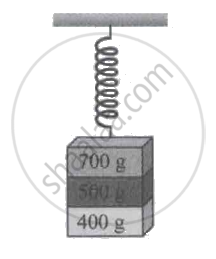Advertisements
Advertisements
Question
A particle performs linear S.H.M. of period 4 seconds and amplitude 4 cm. Find the time taken by it to travel a distance of 1 cm from the positive extreme position.
Solution
Given:
T = 4 s, A = 4 cm = 0.04 m,
x = 1 cm from extreme position = 4 − 1 = 3 cm = 0.03 m
To find: Time taken (t)
Formula: x = A sin (ωt + Φ)
Calculation:
Particle starts from a positive extreme position.
∴ Φ = `pi/2`
From formula,
x = `"A" sin((2pi"t")/"T" + Φ)` ........`(∵ ω = (2pi)/"T")`
∴ 3 = 4 sin`((2pi"t")/4 + pi/2)`
∴ cos`((2pi)/4)"t" = 3/4` ......`[∵ sin(pi/2 + θ) = cosθ]`
∴ `(pi/2)"t" = cos^-1(3/4)`
∴ t = `2/pi xx 41.1^circ xx pi/180 = 41.4/90 = 0.46 "s"`
Time taken by it to travel a distance of 1 cm from the positive extreme position is 0.46 s.
APPEARS IN
RELATED QUESTIONS
A needle of a sewing machine moves along a path of amplitude 4 cm with a frequency of 5 Hz. Find its acceleration `(1/30)` s after it has crossed the mean position.
At what distance from the mean position is the kinetic energy of a particle performing S.H.M. of amplitude 8 cm, three times its potential energy?
Two S.H.M.’s have zero phase difference and equal amplitudes A. The resultant amplitude on their composition will be ______
A simple pendulum moves from one end to the other in ¼ second. What is its frequency?
A particle performing S.H.M. has velocities of 8 cm/s and 6 cm/s at displacements of 3 cm and 4 cm respectively. Calculate the amplitude and period of S.H.M.
Obtain an expression for the resultant amplitude of, the composition of two S.H.M.’s having the same period along the same path.
Two wires of different materials have same length L and same diameter d. The second wire is connected at the end of the first wire and forms one single wire of double the length. This wire is subjected to stretching force F to produce the elongation l. The two wires have ______.
In amplitude modulation,
The total energy of the body executing S.H.M. is E. The kinetic energy of the body, when the displacement is half of the amplitude is ______.
Three masses 700 g, 500 g, and 400 g are suspended at the end of a spring and are in equilibrium as shown in figure. When the 700 g mass is removed, the system oscillates with a period of 3 seconds; when the 500 g mass is also removed, it will oscillate with a period of ____________.

The equation of S.H.M. of a particle of amplitude 4 cm performing 150 oscillations per minute starting with an initial phase 30° is ____________.
The amplitude of sound is doubled and the frequency is reduced to one fourth. The intensity of sound at the same point will be ____________.
A body of mass 1 kg is suspended from a spring of negligible mass. Another body of mass 500 g moving vertically upwards hits the suspended body with a velocity 3 ms-1 and gets embedded in it. If the frequency of oscillation of the system of the two bodies after collision `10/pi` Hz, the amplitude of motion and the spring constant are respectively ____________.
A mass M attached to a horizontal spring executes S.H.M. of amplitude A1. When the mass M passes through its mean position, then a smaller mass m is placed over it and both of them move together with amplitude A2. The ratio of `(A_1/A_2)` is ______
Two trains are moving towards each other with speeds of 20m/s and 15 m/s relative to the ground. The first train sounds a whistle of frequency 600 Hz. The frequency of the whistle heard by a passenger in the second train before the train meets, is ______. (the speed of sound in air is 340 m/s)
A mass m1 connected to a horizontal spring performs SHM with amplitude A. While mass m1 is passing through mean position, another mass m2 is placed on it so that both the masses move together with amplitude A1. The ratio of `"A"_1/"A"` is ______. (m2 < m1)
A sinusoidal wave travelling in the same direction have amplitudes of 3 cm and 4 cm and difference in phase by `pi/2`. The resultant amplitude of the superimposed wave is ______.
The motion of a particle varies with time according to the relation y = a sin ω t + a cos ω t. Then, ______.
A block of mass m, connected to two springs of spring constants k1 and k2 as shown, oscillates on a smooth horizontal surface. What is the effective spring constant of the oscillation?

Light of a certain colour has 2500 waves to the millimetre in air. What is its frequency?
